Complete Solutions to NCERT Based question of chapter NUCLEAR PHYSICS of Class 12 book with complete answers and questions
| Class 12 | PHYSICS |
| Chapter | NUCLEAR PHYSICS |
| NARAYANA | NCERT Based question |
| Number Of Questions | 72 |
| Academic Year | 2023-24 |
Suppose we consider a large number of continers each containing initially `10000` atoms of a radioactive material with a half life of `1` year. After `1` year.
04:59View SolutionThe gravitational force between a H-atom and another particle of mass m will be given by Newton's law: `F=G (M.m)/(r^(2)`, where r is in km and
01:41View SolutionWhen a nucleus in an atom undergoes a radioactive decay, the electronic energy levels of the atom.
01:36View Solution`M_(x) and M_(y)` denote the atomic masses of the parent and the daughter nuclei respectively in a radioactive decay. The Q - value for a `beta-` decay is `Q_(1)` and that for a `beta^(+)` decay is `Q_(2)`. If `m_(e)` denotes the mass of an electrons, then which of the following statements is correct?
04:57View SolutionTritium is an isotope of hydrogen whose nucleus triton contains 2 neutrons and 1 proton . Free neutrons decay into `p+bar(e) +bar(n).` If one of the neutrons in Triton decays , it would transform into `He^(3)` nucleus. This does not happen. This is because
03:45View SolutionHeavy stable nuclei have more neutrons than protons. This is because of the fact that
01:34View SolutionIn a nuclear reactor, moderators slow down the neutrons which come out in a fission process. The moderator used have light nuclei. Heavy nuclei will not serve the purpose because
01:58View SolutionFusion processes, like combining two deuterons to form a `He` nucleus are impossible at ordinary temperature and pressure. The reasons for this can be traced to the fact:
02:53View SolutionSample of two radioactive nuclides `A` and `B` are taken. `lambda_(A)` and `lambda_(B)` are the disintergration constants of `A` and `B` respectively. In which of the following cases, the two sample can simultaneously have the same decay rate at any time ?
10:12View SolutionThe variation of decay rate of two radioactive samples A and B with time is shown in fig.
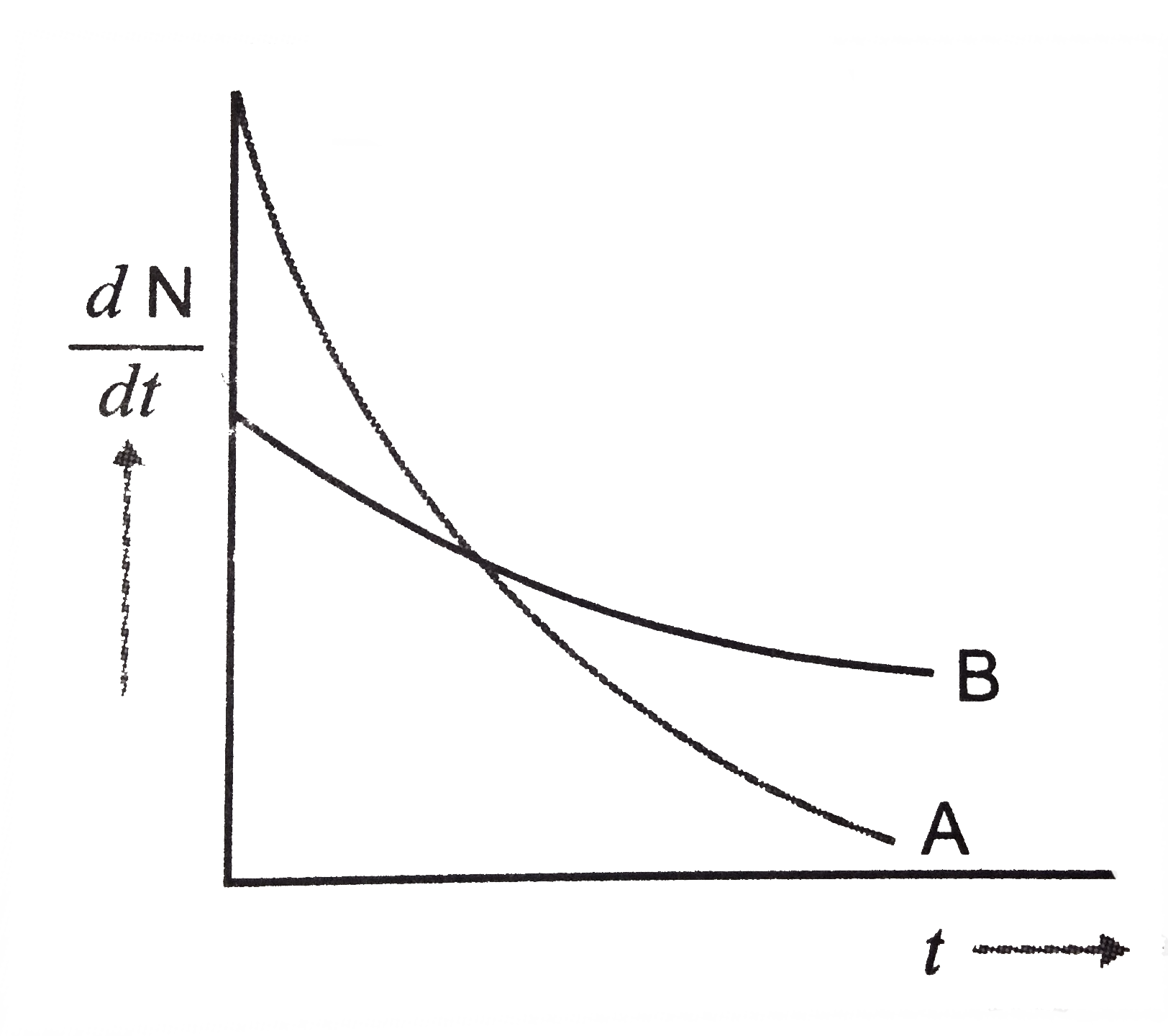
Which of the following statements are true?01:39View Solution`He_(2)^(3)` and `He_(1)^(3)` nuclei have the same mass number. Do they have the same binding energy ?
01:56View SolutionDraw a graph showing the variation of decay rate with number of active nuclei.
00:47View SolutionWhich sample `A` or `B` shown in figure has shorter mean-life ?
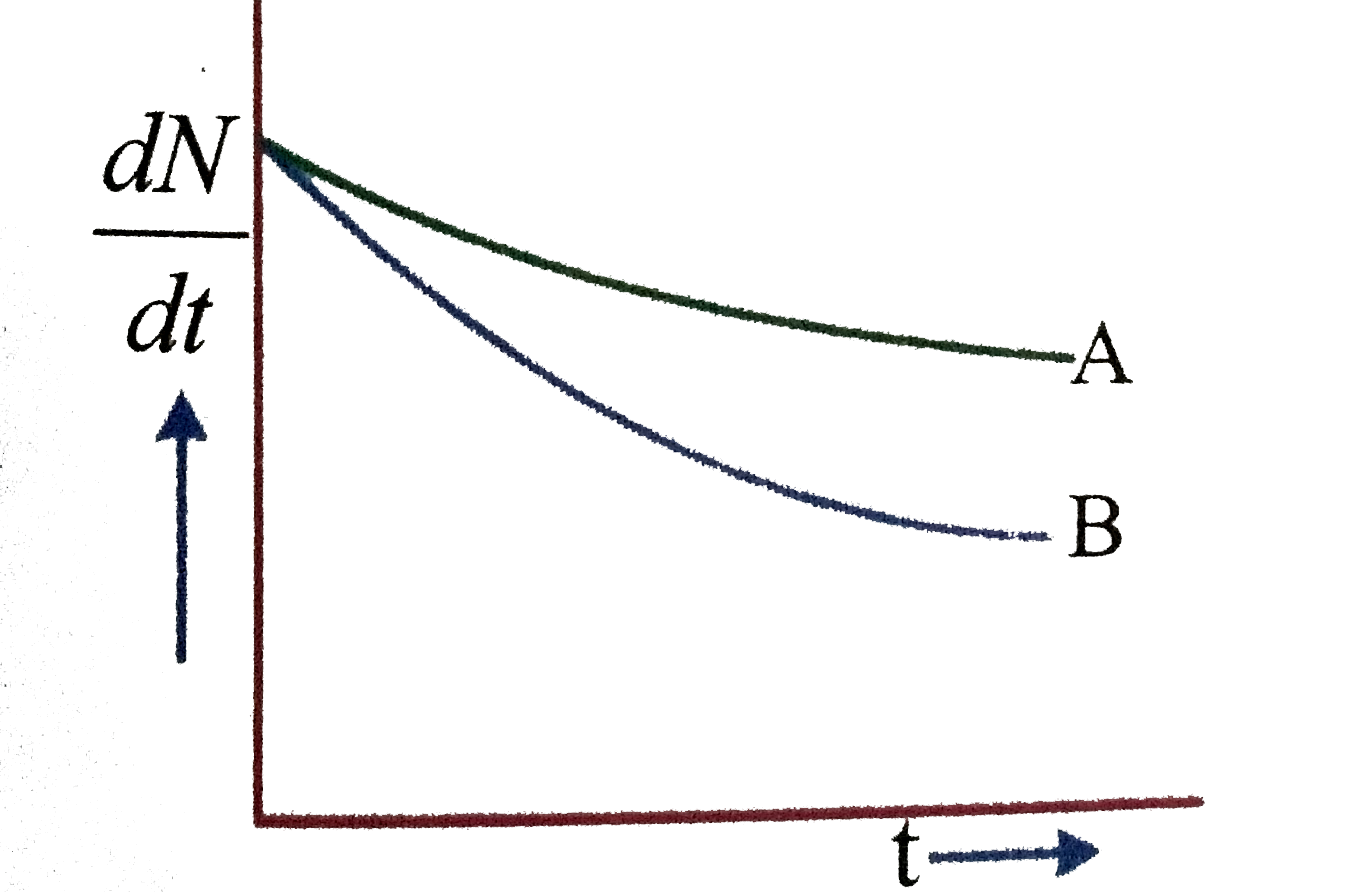 01:43View Solution
01:43View SolutionHeavy stable nuclei have more neutrons than protons. This is because of the fact that
01:34View SolutionConsider a radioactive nucleus A which decays to a stable nucleus C through the following sequence
`A to B to C`
Here B is an intermediate nuclei which is also radioactive. Considering that there are `N_(0)` atoms of A initially , plot the praph showing the variation of number of atoms of A and B versus time.01:25View SolutionTwo radioactive materials `X_(1)` and `X_(2)` have decay constant `11 lambda` and `lambda` respectively. If initially they have same number of nuclei, then ratio of number of nuclei of `X_(1)` to `X_(2)` will be `(1)/(e^(2))` after a time
02:10View SolutionRadon `220` decays to Bismuth `212` by the following series of decay
`{:(._(86)Rnrarr_(84),Po^(216)+_(2),He^(4),,T_(1//2)=55s,),(._(84)Po^(216)rarr_(82),Pb^(212)+_(2),He^(4),,T_(1//2)=0.016s,),(._(82)Pb^(212)rarr_(83),Bi^(212)+_(-1),e^(0),,T_(1//2)=10..6s,):}`
If certain mass of randon is allowed to decay in certain container, after five minutes element with greatest and least mass will respectively be02:33View SolutionFind the half life of `U^(238)`, if one gram of it emits `1.24xx10^4` `alpha`-particle per second. Avogadro's Number `=6.023xx10^(23)`.
02:57View SolutionWhat is the age of an ancient wooden piece if it is known that the specific activity of `C^(14)` nuclide in it amouts to `3//5` of that in fresh trees? Given: the half of `C` nuclide is `5570 years` and `log_(e)(5//3)=0.5` .
01:37View SolutionIn the uranium ore, the ratio of `U^(238)` nuclei to `Pb^(206)` nuclei is `2.8`. If it is assumed that all the lead `Pb^(206)` to be a final decay product of the uranuium series, the age of the ore is `[T_(1//2)` for `U^(238)` is `4.5xx10^(9)` years]
06:29View SolutionThe specific activity of a preparation consisting of radioactive `Co^(58)` and non-radioactive `Co^(59)` is equal to `2.2xx10^(12)` disintergration per sec gram. The half-life of `Co^(58)` os `71.3` days. The ratio of the mass of radioactive cobalt in that prepartaion to the total mass of the prepartion in percentage is
03:35View SolutionAn unstable element is produced in nuclear reaction at a constant rate `R`. Its disintergration constant is `lambda`. Find number of nuclei after time `'t'` if initialy it was Zero
02:54View SolutionTwo identical samples (same material and same amout) `P and Q` of a radioactive substance having mean life `T` are observed to have activities `A_P` and `A_Q` respectively at the time of observation. If `P` is older than `Q`, then the difference in their age is
03:10View SolutionA radionuclide is produced at constant rate `'q'` having half life `T`. Find time after which activity of nuclei will be `A`, if initially number of nuclei were zero.
03:13View SolutionIn an agriculture experiment, a solution containing 1 mole of a radioactive meterial `(t_(1//2)=14.3 days)`was injected into the roots of a plants.the plant was allowed 70 hours to settle down and then activity eas measured in its fruit. If the activity measured was `1 mu Ci` what per cent of activity is transmitted from the root to the fruit in steady state?
09:11View SolutionTo investigate the beta-decay of `Mg^(23)` radionuclide, a counter was activated at the moment `t=0`. It registered `N_(1)` beta particles by a moment `t_(1)=2 sec`, and by a moment `t_(2)=3t_(1)` the number of registered beta particles was `2.66` times greater. the mean life of the given nuclei is
04:16View SolutionNucleus `A` decays to `B` with decay constant `lambda_(1)` and `B` decays to `C` with decay constant `lambda_(2)`. Initially at `t=0` number of nuclei of `A` and `B` are `2N_(0)` and `N_(0)` respectively. At `t=t_(o)`, no. of nuclei of `B` is `(3N_(0))/(2)` and nuclei of `B` stop changing. Find `t_(0)`?
04:13View SolutionA stationary nucleus of mass `24` amu emits a gamma photon. The energy of the emitted photon is `7 MeV`. The recoil energy of the nucleus is
03:43View SolutionA nucleus with mass number `220` initially at rest emits an `alpha`-particle. If the Q-value of the reaction is `5.5 MeV`, calculate the kinetic energy of the `alpha`-particle.
(a) 4.4 MeV (b) 5.4 MeV (c) 5.6 MeV (d) 6.5 MeV04:26View SolutionTwo radioactive substances have half-lives `T` and `2T`. Initially, they have equal number of nuclei. After time `t=4T`, the ratio of their number of nuclei is `x` and the ratio of their activity is `y`. Then,
04:33View SolutionTwo radioactive nuclei `A` and `B` are intially in the ratio `1:4`. Also initial activities of the nuclei are in the ratio `1:8`. Given that, half life of `A` is `2` years, choode the correct alternatives
07:21View SolutionAt `t=0`, number of radioactive nuclei of a radioactive substance are `x` and its radioactivity is `y`. Half-life of radioactive substance is `T`. Then,
03:28View SolutionA nucleus `A` (parent) decays into `B` (Daughter) with half life `T_(1)` and `B` decays into `C` with half life `T_(2)`. Graph is drawn between number of atoms`//`activity versus time. Select the correct graph `(s)`
04:12View SolutionVarious rules of thumb have seen proposed by the scientific community to expalin the mode of radioactive decay by various radioisotopes. One of the major rules is called the `n//p` ratio. If all the known isotopes of the elemnts are plotted on a graph of number of neutrons (n) versus number of protons (p), it is observed that all isotopes lying outside of a ''stable'' `n//p` ratio region are radioactive as shown fig. The graph exhibits straight line behaviour with unit slope up to `p=25`. Above `p=25`, tgose isotopes with `n//p` ratios lying above the stable region usually undergo beta decay. Very heavy isotopes `(pgt83)` are unstable because of their relativley large nuclei and they undergo alpha decay. Gamma ray emission does not involve the release of a particle. It represnts a change in an atom from a higher energy level to a lower energy level.
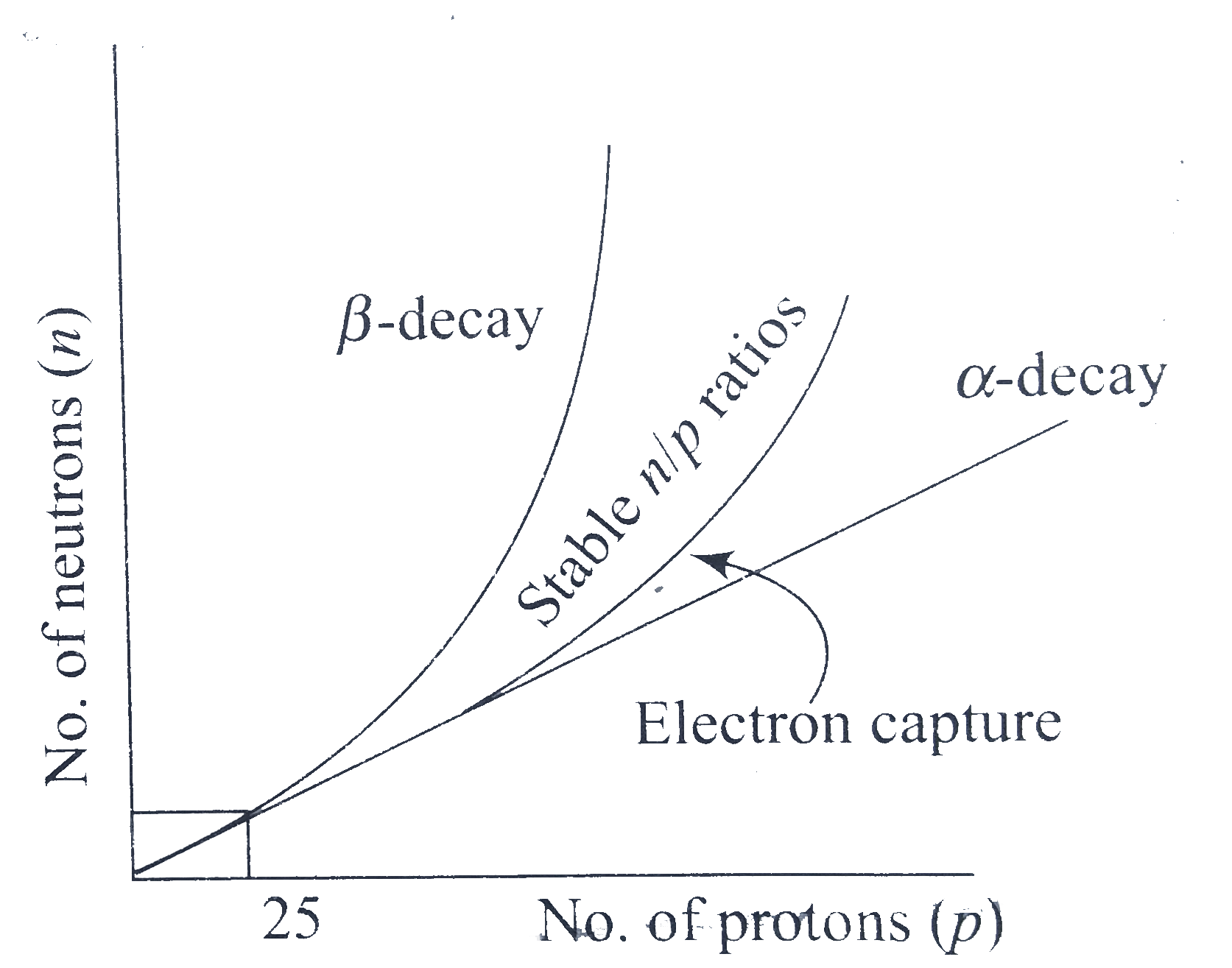
How would the radioisotope of magnesium with atomic mass `27` undergo radioactive decay?.08:43View SolutionVarious rules of thumb have seen proposed by the scientific community to expalin the mode of radioactive decay by various radioisotopes. One of the major rules is called the `n//p` ratio. If all the known isotopes of the elemnts are plotted on a graph of number of neutrons (n) versus number of protons (p), it is observed that all isotopes lying outside of a ''stable'' `n//p` ratio region are radioactive as shown f The graph exhibits straight line behaviour with unit slope up to `p=25`. Above `p=25`, tgose isotopes with `n//p` ratios lying above the stable region usually undergo beta decay. Very heavy isotopes `(pgt83)` are unstable because of their relativley large nuclei and they undergo alpha decay. Gamma ray emission does not involve the release of a particle. It represnts a change in an atom from a higher energy level to a lower energy level.
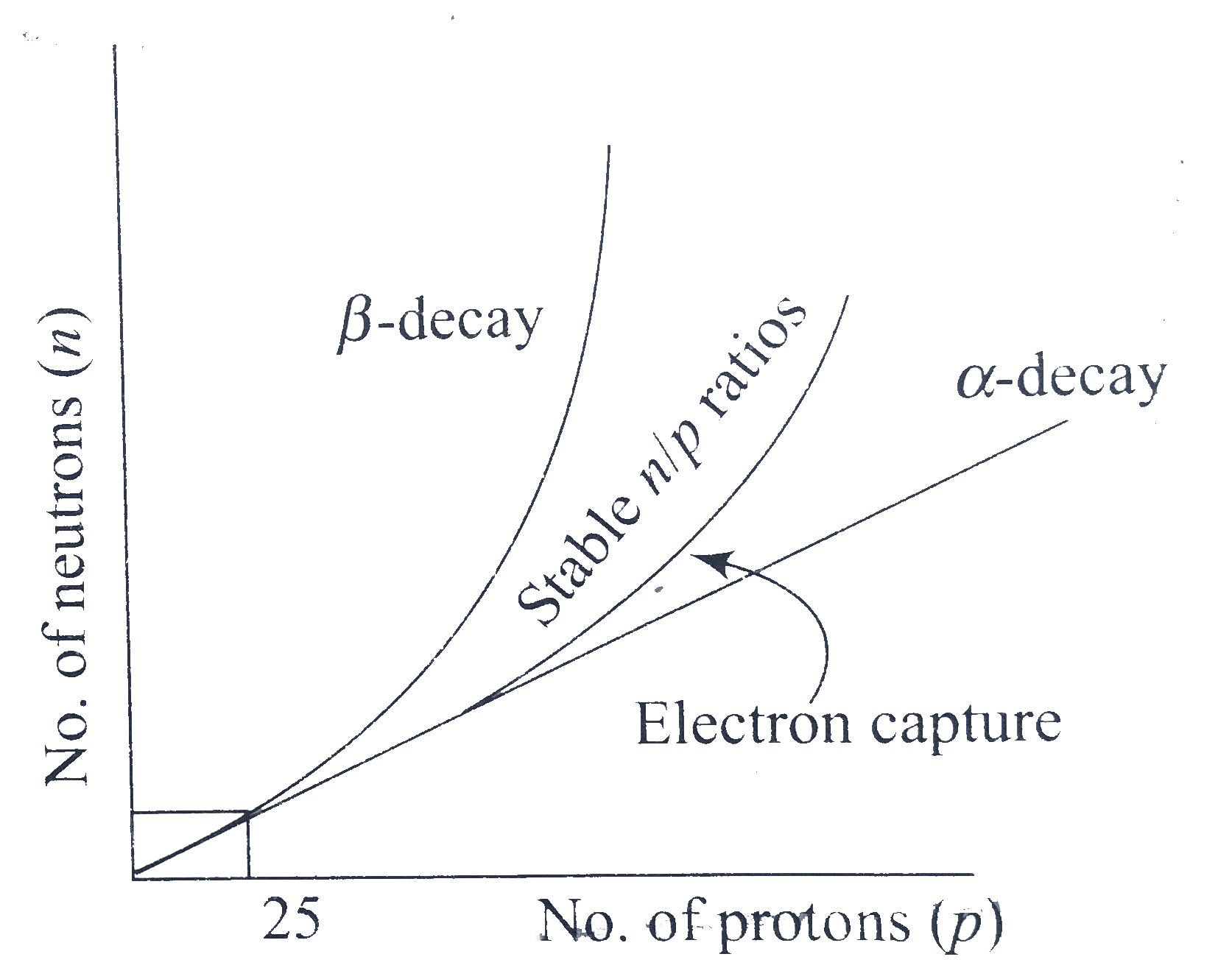
`Th-230` undergoes a series of radioactive decay processes resulting in `Bi-214` being the final product. What was the sequence of the processes that occured?08:43View SolutionVarious rules of thumb have seen proposed by the scientific community to expalin the mode of radioactive decay by various radioisotopes. One of the major rules is called the `n//p` ratio. If all the known isotopes of the elemnts are plotted on a graph of number of neutrons (n) versus number of protons (p), it is observed that all isotopes lying outside of a ''stable'' `n//p` ratio region are radioactive as shown fig.5.28. The graph exhibits straight line behaviour with unit slope up to `p=25`. Above `p=25`, tgose isotopes with `n//p` ratios lying above the stable region usually undergo beta decay. Very heavy isotopes `(pgt83)` are unstable because of their relativley large nuclei and they undergo alpha decay. Gamma ray emission does not involve the release of a particle. It represnts a change in an atom from a higher energy level to a lower energy level.
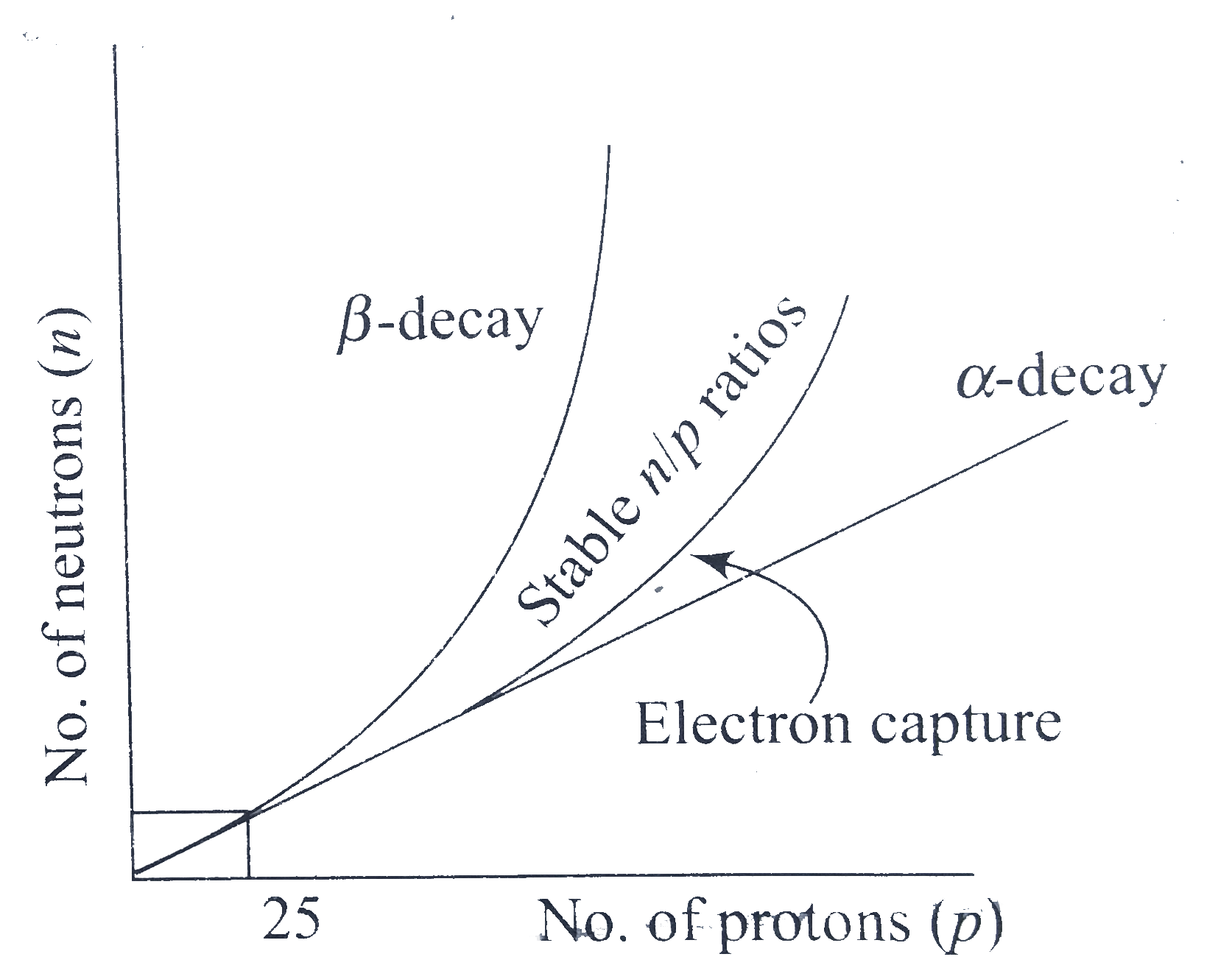
Which of the following represents the relative penetrating power of the three types of radioactive emission in decreasing order?08:43View SolutionThe radionuclide `.^(56)Mn` is being produced in a cyclontron at a constant rate `P` by bombarding a manganese target with deutrons. `.^(56)Mn` has a half-life of `2.5 h` and the target contains large numbers of only the stable manganese isotopes `.^(56)Mn`. The reaction that produces `.^(56)Mn` is
`.^(56)Mn +d rarr .^(56)Mn +p`
After being bombarded for a long time, the activity of `.^(56)Mn` becomes constant, equal to `13.86 xx 10^(10) s^(-1)`. (Use `1 n2=0.693`, Avagardo number `=6 xx 10^(2)`, atomic weight of `.^(56)Mn=56 g mol^(-1)`).
At what constant rate P, `.^(56)Mn` nuclei are being produced in the cyclontron during the bombardment?05:15View SolutionThe radionuclide `.^(56)Mn` is being produced in a cyclontron at a constant rate `P` by bombarding a manganese target with deutrons. `.^(56)Mn` has a half-life of `2.5 h` and the target contains large numbers of only the stable manganese isotopes `.^(56)Mn`. The reaction that produces `^(56)Mn` is
`.^(56)Mn` +`d` rarr `.^(56)Mn` +`p`
After being bombarded for a long time, the activity of `.^(56)Mn` becomes constant, equal to `13.86 xx 10^(10) s^(-1)`. (Use `l n2=0.693`, Avagadro number` =6 xx 10^(23)`, atomic weight of `.^(56)Mn`=`56 g mol^(-1))`.
After the activity of `.^(56)Mn` becomes constant, number of `.^(56)Mn` nuclei present in the target is equal to .05:15View SolutionThe radionuclide `.^(56)Mn` is being produced in a cyclontron at a constant rate `P` by bombarding a manganese target with deutrons. `.^(56)Mn` has a half-life of `2.5 h` and the target contains large numbers of only the stable manganese isotopes `.^(56)Mn`. The reaction that produces `.^(56)Mn` is
`.^(56)Mn +d rarr .^(56)Mn +p`
After being bombarded for a long time, the activity of `.^(56)Mn` becomes constant, equal to `13.86 xx 10^(10) s^(-1)`. (Use `1 n2=0.693`, Avagardo number `=6 xx 10^(2)`, atomic weight of `.^(56)Mn=56 g mol^(-1)`).
After a long time bombardment, number `.^(56)Mn` nuclei present in the target depends upon.05:15View SolutionWhen subatomic particles undergo reaction energy is conserved, but mass is not necessarily conserved. However, a particle's mass 'contributes' to its total energy, in accordance with Einstein'f famouns equation, `E= mc^(2)`
In this question, `E` denotes the equivalent energy when a particle of mass `m` is converted into energy. The particle can also have additional energy due to its motion and its interactions with other particles.
Consider a neutron at rest, and well separated from other particles. It decays into a proton, an electron, and an undetected third particle: `"Neutron"rarr"proton"+"electron"+"third particle"`
The table below summarizes some data from a single nuetron decay. Column `2` shows the rest mass of the particle times the speed of light squared.
`{:("Particle",Mx C^(2),,"Kinetic Energy",),(,(MeV),,(MeV),),("Neutron",940.97,,0,),("Proton",939.66,,0.02,),("Electron",0.51,,0.42,):}`
Assuming the table contains no major errors, what can we conclude about the (mass `x c^(2)` of the undetcted third particle ?06:34View SolutionWhen subatomic particles undergo reaction energy is conserved, but mass is not necessarily conserved. However, a particle's mass 'contributes' to its total energy, in accordance with Einstein'f famouns equation, `E= mc^(2)`
In this question, `E` denotes the equivalent energy when a particle of mass `m` is converted into energy. The particle can also have additional energy due to its motion and its interactions with other particles.
Consider a neutron at rest, and well separated from other particles. It decays into a proton, an electron, and an undetected third particle: `"Neutron"rarr"proton"+"electron"+"third particle"`
The table below summarizes some data from a single nuetron decay. Column `2` shows the rest mass of the particle times the speed of light squared.
`{:("Particle",Mx C^(2),,"Kinetic Energy",),(,(MeV),,(MeV),),("Neutron",940.97,,0,),("Proton",939.66,,0.02,),("Electron",0.51,,0.42,):}`
From the given table, which properties of the undetected third particle can we calculate ?05:23View SolutionWhen subatomic particles undergo reaction energy is conserved, but mass is not necessarily conserved. However, a particle's mass 'contributes' to its total energy, in accordance with Einstein'f famouns equation, `E= mc^(2)`
In this question, `E` denotes the equivalent energy when a particle of mass `m` is converted into energy. The particle can also have additional energy due to its motion and its interactions with other particles.
Consider a neutron at rest, and well separated from other particles. It decays into a proton, an electron, and an undetected third particle: `"Neutron"rarr"proton"+"electron"+"third particle"`
The table below summarizes some data from a single nuetron decay. Column `2` shows the rest mass of the particle times the speed of light squared.
`{:("Particle",Mx C^(2),,"Kinetic Energy",),(,(MeV),,(MeV),),("Neutron",940.97,,0,),("Proton",939.66,,0.02,),("Electron",0.51,,0.42,):}`
Consider an ensemble of particles, all of which have the same positive kinetic energy but different masses. For this ensemble, which graph best represents the relationship between the particle's mass and its total energy ?04:35View SolutionWhen subatomic particles undergo reaction energy is conserved, but mass is not necessarily conserved. However, a particle's mass 'contributes' to its total energy, in accordance with Einstein'f famouns equation, `E= mc^(2)`
In this question, `E` denotes the equivalent energy when a particle of mass `m` is converted into energy. The particle can also have additional energy due to its motion and its interactions with other particles.
Consider a neutron at rest, and well separated from other particles. It decays into a proton, an electron, and an undetected third particle: `"Neutron"rarr"proton"+"electron"+"third particle"`
The table below summarizes some data from a single nuetron decay. Column `2` shows the rest mass of the particle times the speed of light squared.
`{:("Particle",Mx C^(2),,"Kinetic Energy",),(,(MeV),,(MeV),),("Neutron",940.97,,0,),("Proton",939.66,,0.02,),("Electron",0.51,,0.42,):}`
Could this reaction occur ?
`"Proton"rarr"neutron"+"other particles"`05:12View SolutionA beam of alpha paricles is incident on a target of lead. `A` particular alpha paticles comes in 'head- on' to a particular lead nucleus and stops `6.50 xx 10^(-14)` m away from the center of the nucleus. (This point is well outside the nucleus.) Assume that the lead nucleus, which has `82` protons, remains at rest. The mass of alpha particle is `6.64 xx 10^(-27)kg`
Calculate the electrostatic potential energy at the instant when the alpha particle stops?06:36View SolutionA beam of alpha paricles is incident on a target of lead. A particular alpha paticles comes in 'head- on' to a particular lead nucleus and stops `6.50 xx 10^(-14) m` away from the center of the nucleus. (This point is well outside the nucleus.) Assume that the lead nucleus, which has 82 protons, remains at rest. The mass of alpha particle is `6.64 xx 10^(-27)kg`
What initial kinetic energy (in joule and in MeV)did the alpha particle have?06:36View SolutionA beam of alpha paricles is incident on a target of lead. A particular alpha paticles comes in 'head- on' to a particular lead nucleus and stops `6.50 xx 10^(-14)` m away from the center of the nucleus. (This point is well outside the nucleus.) Assume that the lead nucleus, which has `82` protons, remains at rest. The mass of alpha particle is `6.64 xx 10^(-27)kg`
What was the initial speed of the alpha particle?06:36View SolutionA deuterium reaction that occurs in an experimental fusion reactor is in two stage:
(a) Two deuterium `(._1^2D)` nuclei fuse together to form a tritium nucleus, with a proton as a by product written as `D(D,p)T`.
(b) A tritium nucleus fuses with another deuterium nucleus to form a helium `._2^4He` nucleus with neutron as a by - product, written as T (D,n) `._2^4He`.
Compute (a) the energy released in each of the two stages, (b) the energy released in the combined reaction per deutrium. (c ) What percentage of the mass energy of the initial deuterium is released. Given,
`{:(._1^2D=2.014102 am u),(._1^3 T=3.016049), (._2^4 He =4.002603 am u),(._1^1 H =1.007825 am u),(._0^1 n =1.00665 am u):}`.08:09View SolutionA deuterium reaction that occurs in an experimental fusion reactor is in two stage:
(a) Two deuterium `(._1^2D)` nuclei fuse together to form a tritium nucleus, with a proton as a by product written as `D(D,p)T`.
(b) A tritium nucleus fuses with another deuterium nucleus to form a helium `._2^4He` nucleus with neutron as a by - product, written as T (D,n) `._2^4He`.
Compute (a) the energy released in each of the two stages, (b) the energy released in the combined reaction per deutrium. (c ) What percentage of the mass energy of the initial deuterium is released. Given,
`{:(._1^2D=2.014102 am u),(._1^3 T=3.016049), (._2^4 He =4.002603 am u),(._1^1 H =1.007825 am u),(._0^1 n =1.00665 am u):}`.08:09View SolutionA deuterium reaction that occurs in an experimental fusion reactor is in two stage:
(a) Two deuterium `(._1^2D)` nuclei fuse together to form a tritium nucleus, with a proton as a by product written as `D(D,p)T`.
(b) A tritium nucleus fuses with another deuterium nucleus to form a helium `._2^4He` nucleus with neutron as a by - product, written as T (D,n) `._2^4He`.
Compute (a) the energy released in each of the two stages, (b) the energy released in the combined reaction per deutrium. (c ) What percentage of the mass energy of the initial deuterium is released. Given,
`{:(._1^2D=2.014102 am u),(._1^3 T=3.016049), (._2^4 He =4.002603 am u),(._1^1 H =1.007825 am u),(._0^1 n =1.00665 am u):}`.08:09View SolutionSuppose a nucleus initally at rest undergoes `alpha` decay according to equation
`._(92)^(225)X rarr Y +alpha`
At `t=0`, the emitted `alpha`-particles enter a region of space where a uniform magnetic field `vec(B)=B_(0) hat i` and elecrtic field `vec(E)=E_(0) hati` exist. The `alpha`-particles enters in the region with velocity `vec(V)=v_(0)hat j` from `x=0`. At time`t=sqrt3xx10^(6) (m_(0))/(q_(0)E_0)s`, the particle was observed to have speed twice the initial velocity `v_(0)`. Then, find (a) the velocity `v_(0)` of the `alpha`-particles,
(b) the initial velocity `v_(0)` of the `alpha`-particle, (c ) the binding energy per nucleon of the `alpha`-particle.
`["Given that" m(Y)=221.03 u,m(alpha)=4.003 u,m(n)=1.09u,m(P)=1.008u]`.14:45View SolutionA nucleus X, initially at rest , undergoes alpha dacay according to the equation ,
` _(92)^(A) X rarr _(Z)^(228)Y + alpha `
(a) Find the value of `A` and `Z` in the above process.
(b) The alpha particle produced in the above process is found to move in a circular track of radius `0.11 m` in a uniform magnetic field of `3` Tesla find the energy (in MeV) released during the process and the binding energy of the parent nucleus X
Given that `: m (Y) = 228.03 u, m(_(0)^(1)n) = 1.0029 u. `
`m (_(2)^(4) He) = 4.003 u , m (_(1)^(1) H) = 1.008 u `12:36View SolutionA nucleus X, initially at rest , undergoes alpha dacay according to the equation ,
` _(92)^(A) X rarr _(Z)^(228)Y + alpha `
(a) Find the value of `A` and `Z` in the above process.
(b) The alpha particle produced in the above process is found to move in a circular track of radius `0.11 m` in a uniform magnetic field of `3` Tesla find the energy (in MeV) released during the process and the binding energy of the parent nucleus X
Given that `: m (Y) = 228.03 u, m(_(0)^(1)n) = 1.0029 u. `
`m (_(2)^(4) He) = 4.003 u , m (_(1)^(1) H) = 1.008 u `12:36View SolutionUranium `._(92)^(238)U` is an ustable nucleus. It decays to Thorium `._(92)^(238)Th`, which is again an unstable nucleus which further decays to `._(91)^(234)Pa`. Let `._(92)^(238)U` be called `A` of decay constant `lambda_(1)` and `._(90)^(234)Th` is called as `B` of decay constant `lambda_(2)` and stable nuclei `._(91)^(234)Pa` be called as `C`. Here `A` is called parent nucleus and `B` is called daughter nucleus of `A`. Any two adjacent nuclei may be consider parent or daughter nuclei `A, B` and `C` respectively at time `'t'`.
Then we can write `Aoverset(lambda_(1))rarrBoverset(lambda_(2))rarrC`
Rate of disintergration of `A=(dN_(1))/(dt)=lambda_(1)N_(1)`
Rate of disintergration of `B=(dN_(2))/(dt)=lambda_(1)N_(1)-lambda_(2)N_(2)`
Rate of formation of nuclei C is equal to
`(dN_(3))/(dt)=lambda_(2)N_(2)`
If at `t=0`, there are `N_(0)` number of nuclei of `A` where as nuclei `B` and `C` are absent in the sample Answer the following questions
Number of nuclei of `B` at any time `t` is07:37View SolutionUranium `._(92)^(238)U` is an ustable nucleus. It decays to Thorium `._(92)^(238)Th`, which is again an unstable nucleus which further decays to `._(91)^(234)Pa`. Let `._(92)^(238)U` be called `A` of decay constant `lambda_(1)` and `._(90)^(234)Th` is called as `B` of decay constant `lambda_(2)` and stable nuclei `._(91)^(234)Pa` be called as `C`. Here `A` is called parent nucleus and `B` is called daughter nucleus of `A`. Any two adjacent nuclei may be consider parent or daughter nuclei `A, B` and `C` respectively at time `'t'`.
Then we can write `Aoverset(lambda_(1))rarrBoverset(lambda_(2))rarrC`
Rate of disintergration of `A=(dN_(1))/(dt)=lambda_(1)N_(1)`
Rate of disintergration of `B=(dN_(2))/(dt)=lambda_(1)N_(1)-lambda_(2)N_(2)`
Rate of formation of nuclei C is equal to
`(dN_(3))/(dt)=lambda_(2)N_(2)`
If at `t=0`, there are `N_(0)` number of nuclei of `A` where as nuclei `B` and `C` are absent in the sample Answer the following questions ltbgt Numeber of the nuclei of nuclei C at time `t` is11:53View SolutionUranium `._(92)^(238)U` is an ustable nucleus. It decays to Thorium `._(92)^(238)Th`, which is again an unstable nucleus which further decays to `._(91)^(234)Pa`. Let `._(92)^(238)U` be called `A` of decay constant `lambda_(1)` and `._(90)^(234)Th` is called as `B` of decay constant `lambda_(2)` and stable nuclei `._(91)^(234)Pa` be called as `C`. Here `A` is called parent nucleus and `B` is called daughter nucleus of `A`. Any two adjacent nuclei may be consider parent or daughter nuclei `A, B` and `C` respectively at time `'t'`.
Then we can write `Aoverset(lambda_(1))rarrBoverset(lambda_(2))rarrC`
Rate of disintergration of `A=(dN_(1))/(dt)=lambda_(1)N_(1)`
Rate of disintergration of `B=(dN_(2))/(dt)=lambda_(1)N_(1)-lambda_(2)N_(2)`
Rate of formation of nuclei C is equal to
`(dN_(3))/(dt)=lambda_(2)N_(2)`
If at `t=0`, there are `N_(0)` number of nuclei of `A` where as nuclei `B` and `C` are absent in the sample Answer the following questions
The graph `N_(1), N_(2)` and `N_(3)` with time can be best represent byView SolutionA radioactive with decay constant `lambda` is being produced in a nuclear ractor at a rate `q_(0)` per second, where `q_(0)` is a positive constant and t is the time. During each decay, `E_(0)` energy is released. The production of radionuclide starts at time `t=0`.
Which differential equation correctly represents the above process?.07:28View SolutionA radionuclide with decay constant `lambda` is being produced in a nuclear reactor at a rate `a_(0) t` per second, where `a_(0)` is positive constant and `t` is the time. During each decay, `E_(0)` energy is released. The production of radionuclide starts at time `t=0`.
Instantaneous power developed at time `'t'` due to the decay of the radionuclide is03:27View SolutionA radioactive with decay constant `lambda` is being produced in a nuclear ractor at a rate `q_0` per second, where `q_(0)` is a positive constant and `t` is the time. During each decay, `E_(0)` energy is released. The production of radionuclide starts at time`t=0`.
Average power developed in time t due to the decay of the radionuclide is07:28View SolutionA nucleus kept at rest in free space, brakes up into smaller nuclei of masses `'m'` and `'2m'`. Total energy generated in this fission is `E`. The bigger part is radioactive, emits five gamma ray photons in the direction opposite to its velocity and finally comes torest. `["Given" h=6.6xx10^(-34)Js,m=1xx10^(-26)Kg,E= 3.63xx10^(-8) mc^(2), C=3xx10^(8)m//s)`
Fractional loss of mass in the fission is07:56View SolutionA nucleus kept at rest in free space, brakes up into smaller nuclei of masses `'m'` and `'2m'`. Total energy generated in this fission is `E`. The bigger part is radioactive, emits five gamma ray photons in the direction opposite to its velocity and finally comes torest. `["Given" h=6.6xx10^(-34)Js,m=1xx10^(-26)Kg,E= 3.63xx10^(-8) mc^(2), C=3xx10^(8)m//s)`
Velocity of small daughter nucleus is07:56View SolutionA nucleus kept at rest in free space, brakes up into smaller nuclei of masses `'m'` and `'2m'`. Total energy generated in this fission is `E`. The bigger part is radioactive, emits five gamma ray photons in the direction opposite to its velocity and finally comes torest. `["Given" h=6.6xx10^(-34)Js,m=1xx10^(-26)Kg,E= 3.63xx10^(-8) mc^(2), C=3xx10^(8)m//s)`
The wavelength of the gamma ray is07:56View SolutionThe ratio of the radii of the `._(79)Au^(197)` nucleus to that of the radius of its innermost Bohr orbit is nearly `16 x`. Find the value of `x`. (Given `R_(0)=1.2xx10^(-15)m`).
02:20View SolutionThe isotope `._(92)U^(238)` successively undergoes eight `alpha`-decays and six `beta`-decays. The resulting isotope is found to be `._(92-5y)X^(238-4x)`. Find the value of ratio `x//y`.
02:27View SolutionThe alpha activity of a `10 kg` sample of `._(92)U^(235)` that is used in a nuclear reactor is found to be `x xx 10^(-8)` Bq. If the half of life of uranium -`235` for emitting alpha particles is `7.04xx10^(8)` year, then find the value `'x'`. (Given 1 year `=3.15xx10^(7)s`)
04:00View SolutionThe mean lives of a radioactive substance are 1620 years and 405 years for `alpha` emission and `beta` emission respectively. Find out the time during which three fourth of a sample will decay if it is decaying both by `alpha`-emission and `beta`-emission simultaneously. `(log_e4=1.386).`
03:17View SolutionEnergy is released from stars due to nuclear fusion taking place in two cycles proton-proton cycle and carbon nitrogen cycle. In these cycles four hydrogen nuclei combine to from helium nucleus. In this fusion reaction in addition to energy how many number of nutrinous are released ?
02:27View SolutionMean free path `(lambda)` in a fission reaction is the average distance covered by a neutron between two fissions. Generation of nearly `200` neutrons are needed to fission all the nuclei in `10 kg` of `._(92)U^(235)`. If `lambda= 4cm` and the fastest moving neutrons generated in a fission reaction have an energy of `2 MeV`, then the time for `200` neutron generation is found to be `pxx10^(-7)` seconds. Find `'p'`.
04:11View SolutionThere is a stream of neutrons with kinetic energy of 0.0327 eV. If half life of neutrons is 700s, what fraction of neutrons will decay before they travel a distance of 10m? Take mass of neutron =`1.675xx10^(-27)kg.`
03:07View SolutionHalf-life for certain radioactive element is `5 min`. Four nuclei of that element are observed at a certain instant of time. After `5` minutes
STATEMENT-I: It can be definitely said that two nuclei will be left undecayed.
STATEMENT-II: After half-life that is `5` minutes, half of totan nuclei will disintegrate. So, only two nuclei will be left undecayed.01:52View SolutionSTATEMENT-I: It is easy to remove a proton from `._(20)^(40)Ca` nucleus as compared to a neutron.
STATEMENT-II: Inside nucles neutrons are acted on only by attractive forces but protons are also acted on by repulsive forces.05:10View SolutionSTATEMENT-I: It is possible for a thermal neutron to be absorbed by a nucleus where as proton or an alpha particle would need a much larger amount of energy for being absorbed by the same nucleus.
STATEMENT-II: Neutron is electically neutral but proton and alpha particle are positively charged.01:36View SolutionSTATEMENT-I: Consider the following nuclear reaction of an ustable `._(6)^(14)C rarr ._(7)^(14)N + _(-1)^(0)e+ overset(-)v`. In a nuclear reaction total energy and momentum is conserved experiments show that the electrons are emitted with a continous range of kinetic energies upto some maximum value.
STATEMENT-II: Remaining energy is released as thermal energy.01:56View Solution
NCERT Based question questions and complete solutions for chapter NUCLEAR PHYSICS of NARAYANA PHYSICS (HINGLISH) of Class 12
